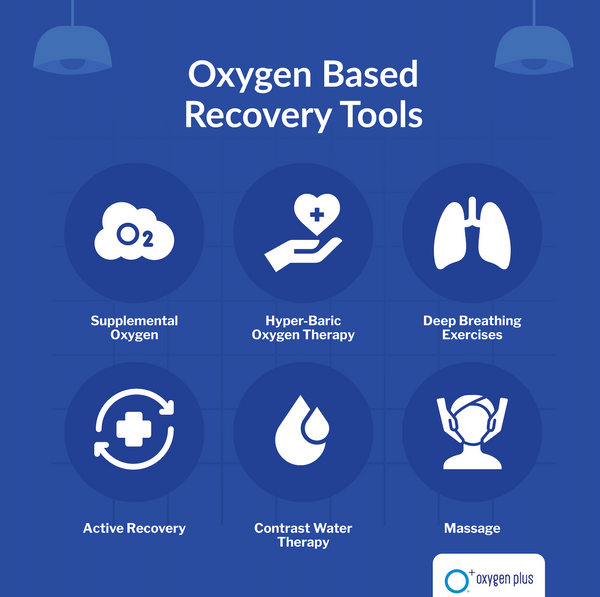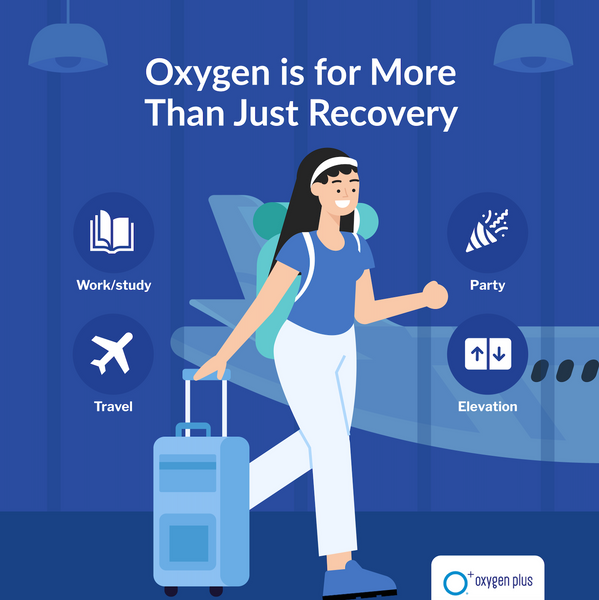Your Cart is Empty
In a 2010 study, researchers measured the oxygen saturation levels in elite athletes who underwent intense workouts on rowing machines. One group breathed pure oxygen, and the other group breathed regular, ambient air in between sessions. The result: When receiving pure oxygen, the athletes rebounded to normal oxygen-saturation levels in 36 seconds, on average, compared with 49 seconds with regular, ambient air.
For the dedicated athlete who thrives on pushing their physical limits, understanding the elements of a fast and effective recovery is crucial to performance. Many of us know about the importance of sleep, rest, nutrition, and hydration, but do you know the science behind how oxygen facilitates the recovery process?
It's important to differentiate between aerobic and anaerobic respiration when discussing the role of oxygen in recovery, as the recovery mechanisms are different processes. As an athlete, you likely experience both types of respiration while participating in your sport.
During aerobic activities, the body relies on oxygen to produce energy. This process, known as aerobic respiration, occurs in the mitochondria of cells and can efficiently generate a large amount of ATP (adenosine triphosphate), which is the energy currency of the cell. Here, oxygen acts as the final electron acceptor in the electron transport chain, a series of reactions that generate ATP through the oxidation of nutrients.
In the context of sport or muscle recovery:
Oxygen plays two significant roles in aerobic recovery:
During aerobic activities, cells use oxygen to break down glucose and fatty acids in a process called aerobic respiration. This process produces ATP, the energy molecule, more efficiently than anaerobic pathways. Oxygen acts as the final electron acceptor in the electron transport chain, a critical step in the mitochondrial ATP production process. The availability of oxygen thus directly influences the rate and efficiency of ATP replenishment.
Oxygen also plays a role in replenishing phosphocreatine stores in the muscle. Phosphocreatine provides a rapid source of ATP during the initial stages of exercise. Post-exercise, oxygen is required to rebuild these stores, preparing the muscles for the next session of activity.

Athletes might use supplemental oxygen post-exercise to rapidly increase the oxygen levels in their blood, thus speeding up the ATP replenishment and tissue repair processes. This can be particularly beneficial after high-intensity or endurance training sessions. Portable oxygen canisters are a common tool, allowing athletes to inhale concentrated oxygen immediately after their workout.
Some athletes turn to HBOT, where they breathe pure oxygen in a pressurized chamber. This therapy can significantly increase oxygen concentration in the blood, promoting faster healing of injured tissues and replenishing energy stores more efficiently than normal atmospheric conditions allow.
Incorporating deep breathing exercises into the cool-down routine can help improve oxygen intake, supporting the body's natural recovery processes by optimizing oxygen delivery to the muscles.
During anaerobic activities, the body relies on processes that do not require oxygen to produce energy quickly for short, high-intensity efforts. This is primarily through glycolysis, where glucose is broken down to produce ATP and lactate as a byproduct. Unlike aerobic respiration, anaerobic metabolism occurs in the cytoplasm of cells and generates ATP at a faster rate, though less efficiently and for shorter durations.
Oxygen plays a crucial role in the recovery from anaerobic exercise, despite the anaerobic activity not directly requiring oxygen for ATP production during the activity itself.
Post-anaerobic exercise, oxygen is vital for lactate removal from the muscles. Once transported to the liver, lactate can be converted back into glucose through gluconeogenesis, which can then be used to replenish muscle glycogen stores or used as fuel. This process, facilitated by increased oxygen availability post-exercise, helps in faster recovery by reducing lactate-induced muscle soreness and fatigue. Phosphocreatine recovery, similar to aerobic recovery, anaerobic recovery also involves the replenishment of phosphocreatine stores, although the initial depletion occurs more rapidly during anaerobic exertion. Adequate oxygen supply post-exercise supports the resynthesis of phosphocreatine, aiding in quicker recovery and preparation for subsequent physical activity.
After intense anaerobic activities, oxygen helps in repairing tissue damage. Increased oxygen delivery to damaged muscles enhances the repair mechanisms, including the activity of fibroblasts for collagen production and angiogenesis for improved blood supply to the repair sites.
Engaging in low-intensity aerobic activities post-anaerobic sessions can increase blood flow and oxygen delivery to fatigued muscles, facilitating the removal of lactate and aiding in muscle recovery. Techniques include light jogging, cycling, or swimming.
Alternating between cold and warm water baths can enhance recovery by improving blood circulation, which helps in lactate clearance and reduces muscle soreness. The improved circulation increases oxygen and nutrient delivery to muscles, speeding up the recovery process.
Massage therapy post-exercise can improve blood flow, thereby increasing oxygen delivery to stressed muscles. This helps in the reduction of lactate levels, accelerates tissue repair, and alleviates muscle tightness and soreness.

As we covered, oxygen is a key component in energy activation and use processes as well as in the recovery process for both aerobic and anaerobic respiration. Understanding how you can use recovery tools specific to the type of respiration in your sport is key to ensuring you are optimizing your recovery time and resources.
Beyond muscle recovery, oxygen can help boost mental clarity and alertness and help take the edge off of a morning after a night on the town. Try Oxygen Plus pure recreational oxygen for the recovery benefits, and to enhance your life – at work, home or play.
